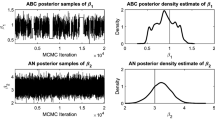Abstract.
We consider distributed networks, such as peer-to-peer networks, whose structure can be manipulated by adjusting the rules by which vertices enter and leave the network. We focus in particular on degree distributions and show that, with some mild constraints, it is possible by a suitable choice of rules to arrange for the network to have any degree distribution we desire. We also describe a mechanism based on biased random walks by which appropriate rules could be implemented in practice. As an example application, we describe and simulate the construction of a peer-to-peer network optimized to minimize search times and bandwidth requirements.
Similar content being viewed by others
References
M.E.J. Newman, SIAM Review 45, 167 (2003)
S. Boccaletti, V. Latora, Y. Moreno, M. Chavez, D.-U. Hwang, Phys. Rep. 424, 175 (2006)
S.N. Dorogovtsev, J.F.F. Mendes, Evolution of Networks: From Biological Nets to the Internet and WWW (Oxford University Press, Oxford, 2003)
M.E.J. Newman, A.-L. Barabási, D.J. Watts, The Structure and Dynamics of Networks (Princeton University Press, Princeton, 2006)
G. Paul, T. Tanizawa, S. Havlin, H.E. Stanley, Eur. Phys. J. B 38, 187 (2004)
L.A. Adamic, R.M. Lukose, A.R. Puniyani, B.A. Huberman, Phys. Rev. E 64, 046135 (2001)
N. Sarshar, P.O. Boykin, V.P. Rowchowdhury, in Proceedings of the 4th International Conference on Peer-to-Peer Computing (IEEE Computer Society, New York, 2004), pp. 2–9
T. Hong, in Peer-to-Peer: Harnessing the Benefits of a Disruptive Technology, edited by A. Oram (O'Reilly and Associates, Sebastopol, CA, 2001), pp. 203–241
P.L. Krapivsky, S. Redner, Phys. Rev. E 63, 066123 (2001)
C. Moore, G. Ghoshal, M.E.J. Newman, Phys. Rev. E 74, 036121 (2006)
M.E.J. Newman, S.H. Strogatz, D.J. Watts, Phys. Rev. E 64, 026118 (2001)
N. Sarshar, V. Roychowdhury, Phys. Rev. E 69, 026101 (2004)
C. Cooper, A. Frieze, J. Vera, Internet Mathematics 1, 463 (2004)
C. Gkantsidis, M. Mihail, A. Saberi, in Proceedings of the 23rd Annual Joint Conference of the IEEE Computer and Communications Societies (Institute of Electrical and Electronics Engineers, New York, 2004)
J.P. Ritter, Why Gnutella can't scale. No, really (2000), http://www.darkridge.com/ jpr5/doc/gnutella.html
M. Ripeanu, I. Foster, A. Iamnitchi, IEEE Internet Computing 6, 50 (2002)
A. Broder, A. Karlin, Journal of Theoretical Probability 2, 101 (1989)
W. Aiello, F. Chung, L. Lu, in Proceedings of the 32nd Annual ACM Symposium on Theory of Computing (Association of Computing Machinery, New York, 2000), pp. 171–180
M.E.J. Newman, Contemporary Physics 46, 323 (2005)
Author information
Authors and Affiliations
Corresponding author
Rights and permissions
About this article
Cite this article
Ghoshal, G., Newman, M. Growing distributed networks with arbitrary degree distributions. Eur. Phys. J. B 58, 175–184 (2007). https://doi.org/10.1140/epjb/e2007-00208-2
Received:
Published:
Issue Date:
DOI: https://doi.org/10.1140/epjb/e2007-00208-2




